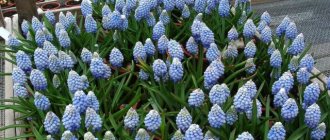Description and characteristics of crocuses
Corm perennials do not have an aboveground stem. The flowers are large, looking up. The six-petalled flowers are goblet or star-shaped and emerge directly from the bulb. Different shades of pink, purple, yellow, lilac, orange and lilac appear immediately after the snow melts.
The peduncle reaches up to 18 cm in height. The flowers are large, up to 7 cm in diameter, with a deep orange pistil. Narrow linear leaves grow during the flowering period or after the flower withers (in spring species).
Important! Saffron blooms only on a good, sunny day, flowering lasts 3-4 weeks. In cloudy and rainy weather, the petals are tightly closed into an unusually beautiful bud.
Crocus flower - botanical description
Crocus flowers are classified as primroses. There is still snow around, but through it yellow, purple or white bells stubbornly make their way to the sun. One flower blooms for no more than three days, and mass flowering lasts about two weeks.
This flower is one of the first heralds of spring. This is why they love to grow it in the garden. The flowers are tiny but bright, symbolizing the awakening of new life.
Legends and traditions
There are many beautiful legends and traditions associated with crocus. Presumably its homeland is India, but the plant was glorified in the manuscripts of Greece and Rome, and the papyri of Egypt. Ancient poets and philosophers, doctors and scientists wrote about him.
In the east, saffron was idolized, although not so much for its beauty as for its opportunity to obtain material benefits. From its stigmas they obtained the most valuable seasoning, dye, flavoring and medicine all in one. The process of collecting and drying saffron threads is so labor-intensive, and the yield of the substance is so small that only aristocrats could afford such a luxury.
In Babylon and Persia, only kings could wear shoes dyed with saffron. And in China, only the emperor could wear yellow saffron clothes. No wonder the flower was called imperial.
Saffron stigmas have been used as a spice and dye for more than four thousand years. To get 1 kg of spices, you need to collect and dry almost weightless strings from 200,000 flowers. It was a very expensive spice. Currently, thanks to modern collection and processing technologies, it has become accessible to mere mortals, and not just a select few.
During the times of the Crusaders, military campaigns and raids, crocuses were brought to Europe. They were first bred in Mediterranean countries, and around the sixteenth century they found their way into the greenhouses of northern countries. They were grown exclusively for decorative purposes; the most popular were the Spring, Yellow and Narrow-Leafed species. Subsequently, they became the main material for obtaining new varieties and hybrids.
Characteristics of the flower
But what is the flower itself? This is a low-growing perennial corm plant belonging to the Iris or Kasatikov family. It barely reaches 10-20 centimeters in height.
A corm differs from a regular bulb in that nutrients for the plant accumulate in the surface scales - the husk.
The bulb is very similar to an onion. In diameter no more than three centimeters, round or slightly flattened. “Dressed” in husks. Every year, many thread-like roots grow from the bottom. The old bulb dies off over the course of a season, and a new, young one forms inside it.
The crocus has no stem; leaves grow directly from the roots. They are narrow, sharp, appear during flowering or immediately after it. Some varieties have a thin white stripe down the center of the leaf.
No more than two or three single, very bright, glass-shaped flowers can grow from one tuber. Based on their color, they are divided into two main groups – yellow and blue. The yellow-flowered species have yellow and orange shades, while the blue-flowered species range from light purple to dark purple. Both groups can have albinos - white flowers. Two-color varieties are very popular.
The crocus has six petals, in the lower part they are fused into a narrow long tube. The stamens and pistil are thread-like, bright orange.
According to the time of flowering, crocuses are also divided into two groups. Spring ones bloom in early March and are more numerous; autumn ones bloom in September and are much less common. In summer, plants are dormant.
Just two saffron stigmas can turn three liters of water bright yellow. A few grams can poison a person or even kill him.
Origin
Crocuses are mysterious flowers; they are covered with various legends and myths. One ancient Greek myth tells of Mercury accidentally killing his friend Crocus. And at the request of Mercury, the gods perpetuated the memory of Crocus. Flowers grew where the young man shed his blood. Every spring these flowers were a reminder of eternal memory.
Another myth is about the young man Crocus, who fell in love with a beautiful nymph. The girl got bored with the passionate courtship, and she turned to the gods. And they turned the young man into a delightful purple flower with deep orange anthers, symbolizing fiery passion.
The flower has two names:
- crocus, from the ancient Greek kroke (thread) - the stigmas of the flower resemble fibrous threads;
- saffron - from Arabic sepheran (yellow).
The Arabs were the first to grow crocuses in the East. Potions and seasonings were prepared from flowers, but they were valued as a natural dye. In ancient China, there was a ban on the use of saffron dye, as it was intended only for the imperial family.
In Europe, the flower became known in the 11th century. It was bred only for economic purposes. The first decorative crocus was brought out only in the 16th century. The country of origin of the flower is considered to be Kashmir (India). According to Buddhist legends, the crocus to Kashmir was sent from heaven by the arhat Nimatun himself. In Tibet, the precious flower is used to produce Tibetan smoking sticks.
What types of crocuses are grown in the country?
In total, there are more than 90 different types of saffron, which grows naturally in Southern and Central Europe, Asia Minor, the Mediterranean, and the Caucasus. And breeders have bred more than 300 decorative varieties of crocuses that are found in landscape designs.
Dutch hybrids
These are the most common varieties, which have huge flowers and grow up to 10 cm. They bloom with lilac, violet and white flowers, and also come in stripes. This variety first appeared at the end of the 19th century, and the most famous were:
- spring crocus . Distributed in nature, and found in the Alps and the mountains of the Balkan Peninsula. What do Dutch crocuses look like? These are flowers with white and lilac buds, the flowering period of which begins in early spring and lasts for a month;
- yellow crocus . Found naturally in Southern Europe and Turkey. The flowers are bright yellow or orange. Blooms for 3 weeks;
- narrow-leaved crocus . Found in Crimea, Asia Minor, and the Balkan Peninsula. Compared to previous varieties, it has smaller flowers of a light yellow color.
Types, varieties
Crocuses are divided into late-blooming and early-blooming, as well as by color and flower size.
Species that bloom in spring
Adams is a lilac flower. The height of the peduncle is 4-6 cm. Flowering occurs in early spring.
Alatavsky - peduncle height 8 cm. The perianth is painted purple on the outside, white on the inside. Blooms in early April.
Banatsky - a tall peduncle produces lilac flowers with bright yellow anthers and lilac stigmas.
Spring - low peduncle. Flower up to 5 cm in diameter. The species has a variety of colors, depending on the variety:
- “Agnes”, “Vangard” - pale lilac color;
- “Joan of Arc”, “Kathleen Parlow”, “Snowstor” - the flower is painted white;
- “Purpureu Grandiflore”, “Remebrance”, “Flower Record” - purple flower;
- "Little Dorrit" - the flower has a blue color with a silver tint.
All varieties bloom in April.
Golden-flowered - peduncle - 8 cm. The flowers are medium-sized, painted yellow or blue.
Large-flowered varieties:
- "Blue Pearl" - pearl blue color;
- "Violet Queen" - purple;
- "Cream Beauty" - yellow;
- "Snowbanding" - white;
- Heuffelliana - 12 centimeter peduncle, produces large flowers of purple, white or lilac, bloom in early spring.
Late flowering species
- Palassa is a late flowering species. Peduncle up to 6 cm high, petals pink-violet with purple veins. The flower blooms at the end of September.
- The beautiful crocus is a large, lilac-violet flower, reaching a size of up to 12 cm. The garden begins to smell fragrant in early autumn.
Popular varieties:
- "Albus" - white;
- "Artabir" - lilac;
- "Cassiope" - blue;
- "Oksonion" - dark blue;
- "Pallux" - light purple.
The flowering time of crocuses depends on the climate and place of growth.
Important! Saffron does not have red flowers.
Features of crocus
Crocus is a low-growing plant, the height of which, as a rule, does not exceed 10 centimeters. The bulbs reach 30 mm in diameter and have a round or flattened shape. The surface of the bulbs is covered with scales, and they also have a bunch of fibrous roots. Shoots of such a plant do not grow. During flowering or after it, narrow linear basal leaf plates grow, they are collected in a bunch and covered with scales. Single goblet-shaped flowers reach 20–50 mm in diameter. The flowers can be colored cream, purple, yellow, white, blue, purple or orange. They bloom on a leafless short peduncle and are surrounded by membranous scales. There are varieties whose flower colors are two-tone or spotted. The duration of mass flowering is from 15 to 20 days. All types and varieties of this plant are divided into 15 groups.
Caring for crocuses. Secrets of abundant flowering
When to plant crocuses
The timing of planting a spring flower depends on the species. Spring - for autumn varieties; autumn – for early flowering species. In spring, late-blooming varieties of crocuses are planted. For saffron, choose a sunny place. Planting is carried out in moist soil, in warm but not hot weather. For early, beautiful flowering, spring-flowering saffron is planted in early autumn.
The depth of the bulb depends on the quality of the soil:
- deepen into light soil to the depth of two bulbs;
- in heavy soil - the bulb is planted to a depth of its size.
The distance between the bulbs is 3-5 cm. After planting, the bulbs are watered.
By planting saffron in the fall, the bulbs will take root and overwinter well, and in the spring they will diversify the garden with bright flowering.
Important! If you plant a spring variety in the summer, the saffron will be able to bloom at the time of frost, which will lead to the death of the plant. And when planted in cold October, the bulb may not take root in the cold soil.
Home growing crocuses
This method is popular among gardeners because it is unusual and gives an original result. It is called forcing, and is carried out only using bulbous plants.
Crocuses are most suitable for forcing. With its help, they can be made to bloom at almost any desired time. But it is more interesting to achieve flowering in winter.
By the way. If you start the forcing procedure in September, you can time the flowering to coincide with the New Year. If forcing is done towards the end of autumn, the flowers will bloom by March 8th.
This process is exciting and like a miracle. Like snowdrops from a fairy tale, which, contrary to the laws of nature, bloomed in December, crocuses bloom on the windowsill of a window covered with snow.
Flowering in a pot
Adult, ripe bulbs that are healthy and free of visible damage are selected for forcing. The process is divided into several stages.
Stage one - stratification
Cold stratification is the first condition for successful forcing of cold-resistant flowers - spring crocuses. Before forcing, the bulbs are sent to the bottom shelf of the refrigerator, with a storage temperature no higher than +5°C, semi-darkness is desirable. There, the bulbs are stratified for at least two months (stratification can be extended to four months if flowering needs to be delayed).
By the way. Some gardeners plant the bulbs directly in a pot and then, together with the container, send them for stratification. This method is only bad because there is not always so much space in the refrigerator. And taking them out onto an open balcony in winter means exposing them to the danger of freezing.
Video - crocus care at home
Stage two - landing
After stratification, the bulbs are planted in pots (if the process has already taken place in pots, they are simply taken out of the refrigerator and the conditions for their maintenance change). Potting soil should contain leaf humus and river sand in large quantities. Long-acting fertilizer granules are added to the soil in advance, or fertilizer in sticks is placed at the bottom of the container.
Important! Crocus bulbs are tightly “settled” in a pot, several at a time. An indispensable condition is that they should “sit” quite closely, but should not come into contact with each other or with the walls of the pot.
The plantings are covered with a layer of fertile soil so that their “heads” do not peek out of the ground. The top of the soil in the pot is mulched with moss or fine gravel, not reaching the edge of the pot two centimeters. Then the plantings are watered.
Video - planting crocuses
Stage three - growth
Plantings are transferred to a place with a cool temperature of +10...12°C and twilight. There they remain until roots emerge from the bottom of the pot and sprouts appear in the soil. This means that the bulbs have taken root and are growing. You can take them to a sunny place and increase the temperature to +20°C (gradually). In the future, they are watered and waiting for flowering.
Winter bloom
By the way. If it is necessary to adjust the timing of flowering, this can be done by moving containers with bulbs. Coolness and lack of lighting slow down the forcing process, while sunlight and heat speed it up.
Stage four - completion of the cycle
After flowers fade or are cut, crocuses should be allowed to complete their growing cycle on their own. When the leaves have completely yellowed and withered, the plants can be planted in open garden soil (in spring). There, those on which flowers were left will “rest” for two years before blooming again. Those from which the flowers were cut will bloom the next year.
Landing for forcing
The flower can also be grown from late winter to mid-spring. Thanks to forcing, saffron can be forced to bloom at any time. Varieties with large flowers are suitable for forcing: “Jeanne d'Arc”, “Pickwick”, “Striped Beauty”, etc.
The most beautiful flowering is produced by bulbs measuring 10 cm or more. Such corms are capable of producing 5-6 peduncles. The month of planting is determined by the desired flowering period. For planting, bulbs are selected of the same size. Up to 10 bulbs are placed in a flat, wide container to a depth of no more than 5 cm. After 1.5 months, the planted crocuses will turn into a beautiful flowering arrangement.
For early flowering, large corms are selected. Purchased bulbs are stored at a temperature of +17 degrees until planting. When forcing your own seed, it is necessary to subject it to temperature treatment. Saffron is also a house flower. It is grown for holidays and for home decoration.
For forcing for the New Year holidays
The bulbs are dug up in June. The seed is kept in the sun:
- week - optimal temperature +34 degrees;
- 14 days – + 20 degrees;
- until mid-August – + 17;
Before planting, the bulbs are stored at a temperature of +9 degrees. Bulbs are planted in late September.
For the spring holidays
The bulbs can withstand:
- until August the temperature is +20 degrees;
- further until landing – +17.
Landing takes place from early October to mid-November. In the fall, saffron that has been driven out can be safely planted in a personal plot.
Crocuses planting
To get a beautiful flower bed of crocuses you need:
- choose a place:
- prepare the ground;
- select bulbs;
- prepare seed for planting.
Selecting a location
Saffron is divided into autumn and spring flowers, and therefore the location is chosen taking into account the flowering period.
Remember! Spring-blooming crocuses need plenty of light.
Autumn varieties grow well in shaded areas, under tree canopies or in compositions with low-growing conifers or evergreens. Spring varieties of saffron do not bloom in the shade, and the autumn variety Sharayana grows much worse in direct sunlight than in partial shade.
Crocuses are planted in groups. To create a beautiful saffron carpet, the bulbs are planted in a 3x3 grid. Per sq. There should be 50 bulbs per meter.
Saffron will also look beautiful in flower beds and flower beds, among spring bulbous plants: daffodils, tulips, hyacinths. This combination will ensure continuous early flowering and provide a spring mood.
Important! Before planting in open ground, the corms are treated in a “Maxim” or “Fundazol” solution. The treatment provides immunity from many diseases.
Crocuses look harmonious in rock gardens. After they wilt, bare areas can be covered with ground cover plants.
Once every five years, saffron is dug up and replanted, since due to the daughter bulbs being formed, there is not enough space for the plant to develop well, and the children take all the nutrients from the ground for their growth.
Soil preparation
Crocuses are very demanding on the soil. It should be light, fertile and well drained. Bulbs may rot in wet soil. If the soil is heavy and clayey, dig it up and add sand, lime or compost.
Sandy soil is poor in mineral elements. Therefore, when preparing the site, peat or leaf humus is added to the ground at the rate of 7 kg per square meter. meter. Loamy or sandy soil does not need to be fertilized. Before planting, the soil is dug up onto the bayonet of a shovel.
Bulb selection
Before purchasing, the bulbs are carefully inspected. They should be free of mechanical damage, signs of disease and rot. The bulbs must be strong, without roots or overgrown stems.
Important! A soft and broken onion is the first sign of rotting.
How to prepare crocus bulbs for planting
Before planting in open ground, bulbs are treated with fungicides to prevent diseases. “Maxim”, “Vitaros”, “Fundazol” or a weak solution of potassium permanganate are suitable for this.
For quick germination, the bulbs are soaked in a growth stimulator: “Kornevin”, “Epin” or “Zircon”.
Important! Before using fungicides and stimulants, you must carefully study the instructions for use.
The bulbs are dipped into the prepared solution and left for half an hour. After processing, you can begin planting in a permanent place. There is no need to dry or wash them.
Crocus planting technology
There are many varieties of crocuses. They differ in color, size and flowering time. Crocuses are divided into autumn and spring varieties.
Autumn varieties of saffron are planted in the spring. Landing occurs at the end of August - beginning of September. Planting too late leads to improper formation of the corm. As a result, the plant will produce a large amount of foliage, but will not flower. The weather during spring planting should be warm, but not hot.
Autumn-blooming varieties are often found in bloom on sale. Planting such flowers is carried out as follows:
- Leaves and flowers are trimmed from the bulb. This procedure will allow the plant to quickly adapt to a new location.
- It is better to buy the plant in a non-flowering form, since the peduncle greatly depletes the tuber.
- When planting such a plant, flowering occurs only the next season.
Autumn planting is intended for early flowering species. The month of planting depends on climatic conditions. The soil should still be warm and moist. After the onset of cold weather, it is better not to plant the plant, since the cold soil will not allow the bulb to germinate and it will die.
The technology for planting crocuses in autumn and spring is the same. For all species, prepare nutritious and moist soil. Treated bulbs are planted to a depth of 4 to 10 cm, the depth depends on the size of the bulb. Large ones are buried, small ones are planted closer to the soil surface.
Important! After flowering, the expanded root system pulls the tuber deep into the ground. And if crocuses are planted for forcing, they are buried in the ground, if for propagation, they are planted shallowly.
Crocus at home: planting and care
Crocuses can be grown at home on a windowsill . Their early flowering will fill the apartment space with a delicate spring aroma.
Choosing a pot
Group plantings of different varieties of saffron in one container look great. The container is chosen in such a way that it can accommodate the onions without allowing them to come into contact with each other, but at the same time it would not be too high.
The material of the pot is not so important; disinfection of the container is important.
The pot is thoroughly washed with soap and doused with boiling water. The procedure is recommended for both new and used containers.
This measure helps prevent the spread of fungal spores and subsequent infection of the bulbs.
Watering
The bulbs need to be watered regularly, but in moderation. The next watering is carried out only after the top layer of soil has dried . Stagnant moisture and high humidity are detrimental to crocuses.
Lighting
For saffron to grow quickly, it needs a lot of sunlight . It is optimal to position the pot so that the sprouts are not exposed to direct sunlight, but the lighting is bright.
Place the pot of crocuses at some distance from central heating appliances. Too dry air also harms tender sprouts.
Humidity level
It is recommended to spray plantings only in very dry air . Moderate humidity combined with a stable temperature of about 15 ° C contributes to rapid flowering.
If the air in the room is too dry, you can place a bowl filled with water near the pot - this will help soften the atmosphere.
Top dressing
Crocuses are fed three times during the active growing season.
Caring for crocuses after planting
Saffron is not demanding in care and is practically not affected by diseases. For its growth and flowering, you must follow several rules of care:
- watering;
- feeding;
- loosening and removing weeds;
- getting rid of wilted leaves and flowers;
- mulching the soil for the winter.
After the shoots appear, the ground around the plant must be carefully loosened and weeded to allow air to reach the roots. Loosening is carried out immediately before watering. This allows moisture to quickly penetrate to the lower layers of the soil.
The plant is drought-resistant and needs watering only during winters with little snow, dry spring and during the flowering period. In summer, the plant enters a dormant period and will not need watering.
Important! When watering, you need to make sure that water does not get on the petals, as drops of water lead to darkening of the flower.
Crocuses need three feedings.
The first feeding is applied immediately before planting the bulb. For rapid growth, the plant needs phosphorus-potassium fertilizers. Potassium should be contained 2 times more than phosphorus. Nitrogenous fertilizers are applied directly into the hole.
The second is during the period of budding and flowering. During this period, the content of potassium and phosphorus is selected in equal parts, since phosphorus plays a large role in the formation of buds and is responsible for the duration of flowering.
The third is after flowering. The content of potassium and phosphorus in the fertilizer should be in equal parts. Crocuses can also be fed with organic fertilizers; compost is used for this.
The most suitable mineral fertilizers for good growth:
- Nitroamoffoska - improves growth, promotes the formation of buds and prolongs flowering.
- Kalifos-N – necessary during the growing season. Improves development and provides immunity to many diseases.
- Azofoska is a complex fertilizer that increases resistance to diseases and enriches the soil with all necessary microelements.
- Superphosphate - used at the beginning of flowering.
- Kemira is a complex fertilizer that improves growth and development, and also protects against fungal diseases.
Important! When planting in autumn, complex and organic fertilizers are not applied.
Autumn delicate crocus flowers - growing according to the rules
When, after a long cold spell, primroses appear from under the melting snow, we cannot get enough of them. One of the first are crocuses, bulbous spring flowers that bloom in March, followed by snowdrops. The flowering period is about a week. After some time, behind the faded buds, the leaves wither and turn yellow. At this moment, the crocuses enter a period of rest. There are also crocuses that end the flowering season and delight with delicate buds in October-November. Be sure to plant crocuses on your property, planting and caring for which do not require any special knowledge or expense - and every spring you will get real pleasure from the first, such long-awaited bright flowers.
Do I need to dig up crocuses after flowering?
Some gardeners dig up corms in the country at this time, while others leave them in the ground. After all, crocuses are perennial flowers that can grow at home in one place for several years. Digging up the root part is also done for preventive purposes in order to select unhealthy and damaged planting material. Selected corms are then planted in a new area in open ground. Of course, if you have crocuses growing right on your lawn, you don’t need to dig them up.
The best conditions for crocuses
When planting crocuses at home, you should follow some care rules:
- These flowers love light, loose and nutritious soil. Excess moisture can have a bad effect on the general condition of the plant. Therefore, if the house is planted in loamy soil, then a small amount of sand and fertilizer should be added to it. Compost, peat or manure are used as soil nutrients.
- Since crocuses are light-loving flowers, they are planted at home in well-lit areas. The abundance of flowering and the size of the flowers directly depends on this. The more light the plants receive, the larger the flowers will be. Planting crocuses at home and at the dacha in a shaded place is not excluded, it’s just that in this case the flower buds will be small.
- Crocuses are readily planted in flower beds, combined with other flowers, for example, tulips, daffodils, hazel grouse, which will ensure continuous flowering of the living composition throughout the spring. As some plants bloom, they will replace others.
- The soil in which flowers grow should always be slightly moist. The young shoots produced by the corm are constantly watered as needed. Before each watering, the top layer of soil must dry out.
- These flowers love fertile soil very much. Therefore, fertilizing of plants at home, planted in nutritious soil during the flowering process, is not carried out. If plants grow in the same place at home for several years in a row, they must be fed. Fertilizers are applied to the soil. Phosphorus-potassium fertilizers are used for crocuses. Phosphorus ensures the massive formation of flower buds and prolongs their flowering period. Potassium keeps the bulbs healthy. Fertilizers are applied three times throughout the season.
The first feeding is carried out at the stage of formation of sprouts, the second - during the formation of flower buds, and the third - after the plants have completely faded.
When first fertilizing, the dose of potassium should be twice as much as phosphorus. During the second and third feedings, both substances should be taken in equal proportions.
How to plant autumn and spring crocuses?
Today, quite a few varieties of crocuses have been bred, including autumn and spring varieties.
Autumn flowers are planted in June. Spring crocuses are planted in September-October. Planting large corms at home is carried out to a depth of 9-11 cm, medium-sized planting material is buried at 5-6 cm. The distance between the bulbs should be at least 5 cm.
If replanting of plants at the dacha is not planned for the next 3-4 years, then they are planted side by side, 3 cm from each other.
Caring for corms at home begins in mid-summer. Just by this time the plants will completely bloom and the leaves will wither. If replanting the plants is not planned, the corms are left in the same place without digging them up. In this case, leaves and dried flowers are trimmed.
In southern regions with warm climates, corms survive wintering quite successfully. In harsh climatic conditions, flower beds with plants need to be covered with fallen leaves or small branches.
If the crocuses are planned to be transplanted to a new location, the corms should be dug up in mid-summer - late June, early July. Planting material must be carefully sorted and only healthy and large bulbs selected for planting. In order for the planting material to be well preserved, it is placed in a well-ventilated room with a temperature of 20-22 degrees.
Forcing crocuses
There is a practice of growing crocuses indoors. Plants grow quite successfully on windowsills. However, caring for indoor flowers is slightly different.
Bulbs should be planted in late autumn and kept in a cool place. A month before you want to have flowers, a pot with bulbs should be placed on the windowsill and watered for several days.
Crocus propagation
Propagating autumn crocuses, just like spring ones, at home is a simple process.
Usually, immediately after the end of the flowering period, the main corm dies, and in its place small baby bulbs form. They are separated and seated separately. A year after planting, young crocuses should bloom. As soon as they become crowded, the flowering of crocuses becomes less abundant and the flowers turn out small. To prevent this, the plants are replanted. Typically, crocuses are replanted in the country every 4 years. You can also get new plants from seeds at home, but most often they lose their varietal characteristics. But hybridization is difficult to carry out - you need to have special skills. It is best to buy crocus bulbs in specialized stores.
Autumn or spring crocuses are flowers that are very often used to decorate alpine slides, flower beds, borders and ponds. These plants go well with scillas, primroses and other corms.
LetovSadu.ru
Plant care after flowering
In June and July, the leaves of crocuses begin to dry out. If the plant remains until the next season, only the leaves are removed from the flower. And if the bulbs are dug up, then in the middle of summer it is necessary to:
- Remove faded flowers so that the plant does not waste energy on producing seeds.
- Reduce watering to quickly dry the foliage and drain all nutrients directly into the bulb.
After the leaves dry, the bulb is dug up and dried. They are cleaned of scales and discarded from sick and rotten ones.
Store the bulbs in a cool and ventilated room at a temperature of 18-20 degrees. Crocuses are a frost-resistant plant, but in unfavorable climatic conditions the bulbs are mulched with dry grass or spruce branches. This will help the corm survive the winter even in severe frosts.
When and how to replant crocuses
It is recommended to replant saffron every 5 years, since a large bulb produces daughter bulbs every year. They grow quickly and begin to interfere with each other and fully develop. It is necessary to dig up crocuses during the dormant period, which occurs in mid-summer. The dug up bulbs are inspected and rejected. Sick and damaged bulbs are not suitable for further planting.
Healthy bulbs are peeled and left to dry. From June to August, corms are stored at a temperature of +22 degrees.
Important! If the temperature is below +22, the flower bud will not be able to form.
In August, for hardening, the air temperature is lowered to 15 degrees. Growing saffron without digging leads to the appearance of diseases, the plant grows and stops flowering.
Crocus propagation
Crocuses are propagated in two ways:
- seeds;
- daughter bulbs.
The simplest method is reproduction by division by children. The large, mother bulb, during growth, forms accessory bulbs in the scaly sinuses. After digging, the children are carefully separated, discarded and left for storage until planting. Before planting, the seed is treated with fungicides to prevent diseases.
Reproduction by children will allow you to preserve the variety and grow a large and beautiful flower bed, since one mother bulb produces up to 10 daughter bulbs.
Propagation by seeds
Spring and autumn are the most favorable times for growing crocuses from seeds. Despite the fact that saffron grown from seeds begins to bloom only in the 3rd year, this method is widely used.
The method is not suitable for beginners and is used:
- for breeding rare varieties that do not propagate vegetatively;
- for removing a large number of corms.
Seeds begin to be prepared for sowing in early April. To obtain healthy and strong seedlings, freshly harvested seed material is used.
Before sowing, it is necessary to carry out pre-sowing preparation of seeds:
- disinfection - treatment in a weak solution of potassium permanganate;
- stimulation - for rapid germination, seeds are immersed for half an hour in Kornevin or Epin;
- stratification followed by planting - the seed is kept in the refrigerator for 14 days.
Important! Before the disinfection procedure, the seeds are pre-soaked, since dry seeds are burned even in a weak solution of potassium permanganate.
Stratification technique:
- Seeds are sown superficially in damp sand.
- The container with seed material is covered with film and put in the refrigerator.
- After 2 weeks, the container is buried in open ground, in warm, nutritious soil.
- For rapid germination, the planting site is covered with covering material.
- Seedlings are watered using a spray bottle.
Seeds can be sown directly in open ground:
- Only spring-flowering varieties can be grown in open ground;
- sowing is carried out without hardening, in September;
- Before sowing, the seeds are disinfected and stimulated.
Important! Seeds are sown in light, nutritious and well-drained soil.
Planting in open ground
When to plant
Spring-flowering saffron species are planted in open ground in the fall. Those varieties that bloom in autumn are planted in summer. A sunlit bed is better suited for the crop, although flowers also grow in shaded areas.
It is advisable to plant the crop in light, dry soil that is saturated with nutrients. Preparing the area for planting includes drainage using coarse sand or fine gravel. As an organic fertilizer, before digging, you need to add manure, compost or a mixture of lime and peat to the soil.
On a note! The culture does not like acidic soils. If the soil is clayey, this can be corrected by adding wood ash.
There are varieties of saffron that do not grow in wet soil. For such varieties, gardeners recommend creating high beds where gravel or crushed stone is used as a drainage layer.
If you plant the bulbs in open ground in September, you can admire the blooming crocuses in the spring. The bulbs are planted in loose soil, while deepening them into the ground by one amount. It is necessary to maintain a distance of 8-10 cm between plantings. Planted flowers need good watering. You shouldn’t plant crocuses too close to each other, because they grow in one place for about 4 years. During this time, the crop has “babies”, and the row spaces are gradually overgrown with flowers. After 5 years, flowers are transplanted.
Planting for forcing
Some gardeners like to grow garden flowers at home in winter. The easiest way to grow crops that grow with the help of bulbs. Flower growers recommend selecting Dutch varieties of crocuses for forcing. 5-9 bulbs are selected, which should be the same size. They are planted in a pot, preferably one that is not too deep and has sufficient width. As a result, you will receive a beautiful bouquet of spring flowers. The pot is filled with loose neutral soil, which allows air and water to pass through well. There is no need to throw away faded bulbs.
Crocus bulbs
For successful growth and flowering, it is important to provide high-quality watering and fertilization with a weak solution of mineral fertilizer. When the leaves begin to dry out, you should gradually limit watering until it is completely completed. After the foliage has completely dried, the bulbs should be removed from the container. The remaining soil is shaken off and placed in a paper box. Then the material is hidden in a dry, dark place, where it is stored until autumn.
Pests and diseases of crocuses
Saffron is unpretentious and disease-resistant, but if planting and care rules are not followed, it can be susceptible to fungal and viral diseases. Rodents are carriers of viral infection. Viral diseases are much less common than fungal diseases.
Fungal diseases include:
- rust;
- rot;
- chlorosis;
- mosaic.
Fungal spores affect not only the bulbs, but also the leaves, stems and flowers. The diseased plant lags behind in development and growth, and the flower quickly withers. Without treatment, the plant dries out and dies.
Chlorosis - occurs due to a lack of phosphorus, iron and boron. The disease affects the above-ground part of the plant. The leaves curl and become light yellow in color. The buds are deformed. Treatment consists of treatment with fungicides. Prevention: timely removal of weeds.
Rust - develops on poorly drained soil and with excess nitrogen. Rust attacks leaves and bulbs. Orange spots form on the bulbs, and orange tints appear on the leaves. Fungal spores are spread by rain, wind and aphids. Treatment: copper-containing drugs.
Root rot - appears on heavy soil due to poor air exchange, as well as when there is an excess of moisture. Rot affects the corms, forming brown ulcers on them. If left untreated, the bulb rots and the plant dies. Treatment: Bordeaux mixture.
Mosaic - the disease develops due to mechanical damage to the bulb. Affects leaves and flowers. Deformation and change in color of leaves and flowers occurs. Treatment consists of treating the plant with a copper-containing solution.
Prevention from diseases:
- Timely removal of weeds, as weeds are carriers of disease.
- Treatment of bulbs before planting.
- Disinfection of seeds in a weak solution of potassium permanganate.
- Planting plants in well-drained soil, since stagnation of water has a detrimental effect on the primrose.
- Timely treatment and removal of infected specimens.
Mr. Summer Resident advises: useful tricks for growing crocuses
Experienced gardeners know how to achieve bright and large crocus inflorescences for several years. To make plants feel comfortable, you need to:
- Fertilize twice a year. In early spring, when areas of soil are barely exposed, water the place where the flowers grow with a solution of urea or ammonium nitrate. Immediately before or immediately after flowering, complex potassium-phosphorus fertilizers are introduced. It is also necessary to supply additional minerals and trace elements because after the active division of the mother bulb, the crocus may not have enough strength to bloom. This is especially true for those hybrids that bloom in autumn.
- During active flowering, cut off faded buds. In their place, new ones will form, which means it will be longer.
- Carefully inspect the leaves and flowers. The appearance of dark spots and a sticky coating may indicate a thrips infestation. If this happens, the diseased plant is destroyed, and the soil is spilled with a hot solution of potassium permanganate.
- Transplant and cultivate bulbs only after the leaves wither and fall off and the plant goes into a dormant state. Then the bulbs are dug up, dried, sorted and treated for pathogens. They can be planted again in the fall.
- Loosen and weed the flowerbed, while being careful not to damage the delicate underground part.
- Water the flower bed during the dry summer months, even after flowering has ended. At the same time, do not allow overflow.
To get a variegated carpet of crocuses, flower lovers plant mixes of various hybrids. Calyxes, stems and leaves of different sizes create a multi-layered, pleasing picture.
Blooming crocuses
The flowering period of crocuses is short, about 14 days, but even during the short flowering period, the plant gives an incredible atmosphere to the garden in spring. After flowering, the plant enters a dormant period. This period occurs in the middle of summer.
If the plant remains to overwinter in a permanent place, faded flowers and leaves are cut off. If it's time to dig up a plant, you need to follow some rules:
- yellowed leaves serve as a signal for digging;
- The root system of the plant is delicate; it must be removed from the ground very carefully;
- the dug up bulbs are dried and discarded;
- Store until next planting in a cool, dry place.
Wintering crocuses
Crocuses under the snow
Proper wintering of corms is an important component of caring for crocuses. During wintering, crocus corms take root and gain strength for growth, development and flowering.
Before the onset of frost, the plant can be covered, however, in warm regions, crocuses easily overwinter without additional insulation. Branches and spruce branches, in addition to protection from the cold, are used as a barrier against rodents that like to feast on crocus corms.
With the onset of spring, the insulation is removed and garbage is removed. You can loosen the soil around the crocuses for the first time only after the first shoots appear, otherwise you can damage the root system of the plant.
The reason when crocuses do not bloom and what to do in this case
Thickened planting . The bulbs are cramped and lack nutrients for growth and development. Saffron is replanted every 5 years, since the main bulb produces 5-10 additional bulbs annually. Children grow and prevent each other from fully developing. The solution to the problem is to replant the plant.
Recessed planting of the bulb . Flowering does not occur due to lack of strength to release the peduncle, since all nutrients are directed to the release of basal leaves. In order to achieve flowering, the plant is dug up and planted to a certain depth: small bulbs - 3 cm, large ones - 10 cm.
Lack of nutrients . Untimely feeding of plants leads to a lack of flower stalks. Crocuses are fed three times a season: during planting, during budding and after flowering. If a plant grows for a long time in the same place, the soil becomes depleted over time and the plant does not receive the nutrients responsible for the growth and development of the plant.
Choosing a location . A sunny place is an indispensable condition for their flowering. 5. Planting method. When planting crocuses with seeds, flowering occurs in the fourth year.
Transfer
When transplanting, flower growers are guided by the following rules:
- potted home crocuses are replanted annually in the spring;
- Garden plants do not need to be replanted for 3-4 years, but it is still better to do this also after each flowering.
It is necessary to dig up and replant during the summer dormancy period:
- June-August – autumn-blooming ones are dug up;
- July-September – spring flowering crops are available.
With annual digging, the children get room to grow, it is possible to cull sick individuals and select material for forcing.
Crocuses in landscape design, combination with other plants
Saffron has found great use in creating beautiful landscapes in summer cottages - in a flowerbed, in a mixborder, in a garden bed, as a flower carpet or in small groups. For this purpose, primroses with a variety of colors are used.
Crocuses go well with other bulbous plants such as tulip, daffodil, and hyacinth. With this combination, you get an irreplaceable spring landscape that will decorate any garden.
Crocuses look expressive on alpine hills and rock gardens. Bright colors set off the gray appearance of rocky structures. After flowering has ended, ground cover or low-growing annuals are planted in place of the saffron.
In flower gardens, saffron is combined with low-growing shrubs. The varied colors of crocuses harmonize well with low-growing conifers and evergreens. Dutch, large-flowering varieties make beautiful patterns on lawns.
When planting on lawns, you need to be extremely careful when mowing the lawn, since the green leaves provide the bulb with all the necessary nutrients for further flowering. Autumn flowering species are planted in shady corners of the garden, since the plant does not bloom well in bright sun.











